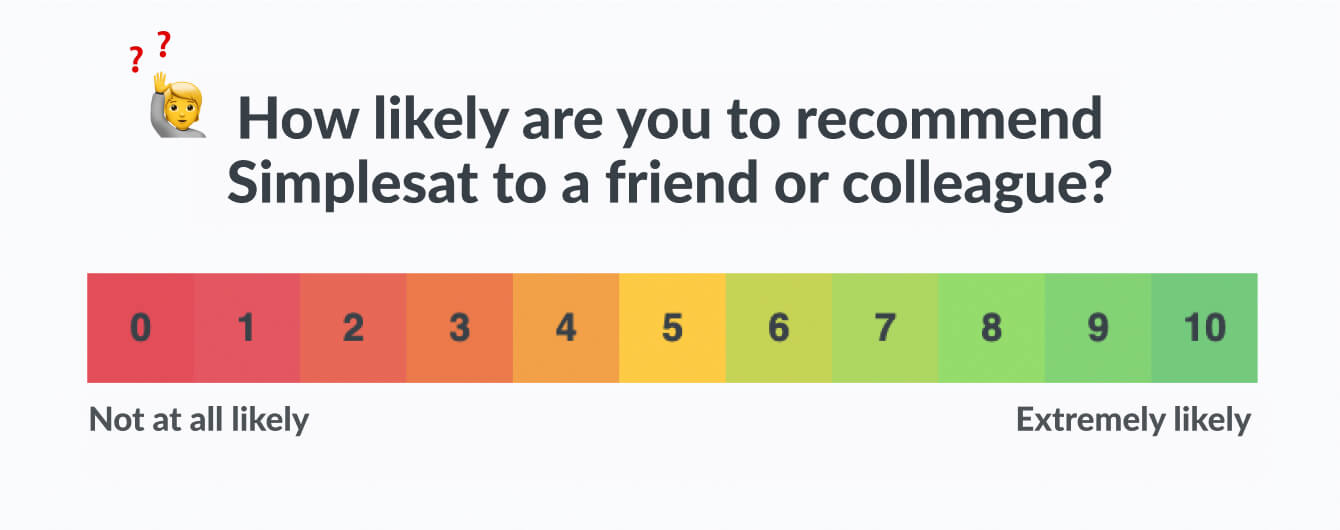- “How likely are you to recommend our product to a friend or colleague?”
That’s the core question in Net Promoter Score (NPS) surveys, and experience shows that it’s effective in measuring customer loyalty – that’s why two out of three Fortune 1000 companies use NPS surveys to keep a finger on the pulse of their user base.
A higher NPS score implies that customers like what you’re doing overall. The lower the score, the bigger the risk of churn. The score is simple to calculate and relatively objective. That makes it a handy statistic to share with investors, partners, or potential customers.
But your NPS doesn’t convey much information in and of itself. It’s just a number between -100 and 100.
Instead, NPS scores have a contextual meaning. To tell whether your NPS score is good enough, you have to measure it against relevant data.
First, how to calculate your NPS score?
NPS surveys come with a 11-point scale (from 0 to 10). Respondents are grouped based on the rating they leave.
- 😍 Promoters are the customers who rate your company at a 9 or a 10. These customers think your company is an all-star and they’re ready to spread the word to their friends.
- 😐 Passives rate your company at a 7 or 8 on the survey. These people are neither very dissatisfied nor very satisfied.
- 😡 Detractors leave a rating of 6 or less. These are the customers most likely to spread negative word-of-mouth about your company and least likely to provide repeat business.
Once you’ve categorized your customers, there are just three simple steps to follow.
- Calculate the percentage of Promoters (divide the number of Promoters by the total number of respondents).
- Calculate the percentage of Detractors (divide the number of Detractors by the total number of respondents).
- Subtract the percentage of Detractors from the percentage of Promoters.

Once you’ve done the subtraction, you can drop the percent sign. This is your raw NPS, and it falls somewhere between -100 and 100.
What you need to know about NPS benchmarks
As a general rule, a negative NPS score is a problem. If you have more detractors than promoters, you should immediately shift focus and start figuring out why your customer base is unhappy.
But beyond that, there is no certain way to tell you whether you’re doing well enough based on your NPS score alone.
NPS benchmarks by industry
NPS scores vary greatly by sector. According to Statista, Insurance and Education are the two sectors with the highest worldwide average NPS score (around 70). The same study shows that Healthcare has the lowest average score at 27.
Some other notable data points:
- 👉 The average NPS for SaaS businesses is 30, and the enterprise software industry has an average NPS score of 44.
- 👉 For eCommerce businesses, the average NPS score is 62.
- 👉 In the world of consulting, the average NPS score is 51.
- 👉 Digital marketing agencies score an impressive average of 61, while eCommerce agencies have a score of 48

However, looking at the industry average is just the first step toward benchmarking your own score.
Understanding your NPS score in context
There are other factors you have to take into account. Ask the following questions:
- What are the average NPS scores of your direct competitors? Certain niches have significantly higher or lower scores compared to their industry as a whole.
- How do you compare to other businesses in your area? Regional differences have more of an impact on NPS results than you’d think. Famously, average scores in the US or Brazil are higher than in Japan or Australia, and that’s true across industries. There are even differences between the rating habits of people living in cities versus customers from rural areas.
- How does your current score compare to your NPS score 6 months ago? That is the most solid way to measure progress. However, it’s important to note that overall NPS scores dropped during the pandemic, and they are sensitive to other large-scale events.
What can you do to increase your NPS score?
Unfortunately, some businesses get caught up in chasing a higher score, to the detriment of making real progress. They find ways to manipulate the customers into leaving a higher rating.
Needless to say, that’s counterproductive. Your NPS score is an important tool but only if you use it the right way.
Make sure to give your customers a chance to explain their pain points. Adding an open-ended follow-up question can help you gain clarity!
It’s also important to reach out to Detractors and maybe even Neutrals. You want to show your customers that you care about their happiness and want to address any lingering issues they have.
Finally, if your customers seem generally happy but still give you low NPS ratings, try tweaking the question (for example, “Would you recommend us to a loved one?” works well in some industries) or change the layout of the survey. Use design elements or followup text to make it clear that 7 and 8 are not considered ‘good’ ratings on this scale. Remember, communication is a two-way street — it’s easier to gain good feedback when you explain where you’re coming from.

About Simplesat: Simplesat is the leading omnichannel survey app designed to enhance customer feedback management across various platforms, including Zendesk, Salesforce, and Gladly. Trusted by businesses worldwide, Simplesat delivers actionable insights that drive business growth and customer satisfaction.









